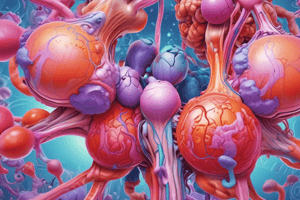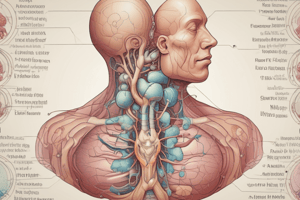Podcast
Questions and Answers
Which hormone is primarily responsible for increasing the size and number of mitochondria within cells?
Which hormone is primarily responsible for increasing the size and number of mitochondria within cells?
- Triiodothyronine (T3) (correct)
- Thyrocalcitonin
- Thyroxin (T4) (correct)
- Insulin
What effect do elevated thyroid hormone levels have on protein synthesis?
What effect do elevated thyroid hormone levels have on protein synthesis?
- Stimulates protein synthesis at normal levels but causes catabolism at high levels (correct)
- Inhibits protein synthesis only
- Stimulates protein synthesis at all times
- Stimulates protein catabolism
What is the primary action of tri-iodothyronine (T3) and thyroxin (T4) on carbohydrates?
What is the primary action of tri-iodothyronine (T3) and thyroxin (T4) on carbohydrates?
- Stimulate glycogen formation
- Increase fat storage
- Increase glucose level and utilization (correct)
- Decrease blood glucose levels
Which body system experiences increased heart rate and contractility due to thyroid hormone action?
Which body system experiences increased heart rate and contractility due to thyroid hormone action?
How do thyroid hormones affect the gastrointestinal tract?
How do thyroid hormones affect the gastrointestinal tract?
Which component is NOT a metabolic function of thyroid hormones?
Which component is NOT a metabolic function of thyroid hormones?
What is thyrocalcitonin primarily associated with?
What is thyrocalcitonin primarily associated with?
What is the structural difference between T3 and T4?
What is the structural difference between T3 and T4?
Flashcards
What are thyroid hormones and where are they produced?
What are thyroid hormones and where are they produced?
Thyroid hormones are produced by the thyroid gland, a butterfly-shaped gland located in the neck, and they play a crucial role in regulating metabolism, growth and development.
What are the two main thyroid hormones and what are their key components?
What are the two main thyroid hormones and what are their key components?
The two primary thyroid hormones are thyroxine (T4) and triiodothyronine (T3). Both contain iodine and are composed of two linked tyrosine amino acids, with T4 having 4 iodine atoms and T3 having 3.
How do thyroid hormones impact the metabolic rate?
How do thyroid hormones impact the metabolic rate?
Thyroid hormones act on the mitochondria, increasing their size and number. This boost in mitochondrial activity leads to enhanced ATP production, resulting in an elevated basal metabolic rate and energy consumption.
How do thyroid hormones affect carbohydrate metabolism?
How do thyroid hormones affect carbohydrate metabolism?
Signup and view all the flashcards
How do thyroid hormones influence fat metabolism?
How do thyroid hormones influence fat metabolism?
Signup and view all the flashcards
How do thyroid hormones affect protein metabolism?
How do thyroid hormones affect protein metabolism?
Signup and view all the flashcards
How do thyroid hormones affect body systems?
How do thyroid hormones affect body systems?
Signup and view all the flashcards
Study Notes
Endocrine System Overview
- The endocrine system is a complex network of glands and hormones that regulate various bodily functions.
- The endocrine system is composed of various glands, each with specialized functions that influence the human body.
Thyroid Gland and Hormones
- The thyroid gland secretes thyroid hormones, essential for proper bodily function.
- Thyroid hormones are produced by follicular cells and include thyroxine (T4) and triiodothyronine (T3).
- Parafollicular cells produce another hormone, calcitonin, which regulates calcium levels.
- Thyroid hormones contain iodine.
- T4 is primarily a transport form and is converted to T3 in periphery.
- T3 is the active form and is more potent than T4.
- T3 has a shorter half-life compared to T4.
Transport and Regulation of Release
- Most released T3 and T4 immediately bind to plasma proteins (e.g., albumin, prealbumin, thyroxine-binding globulin (TBG)) produced by the liver.
- More than 99% of thyroid hormones are bound and less than 1% is free.
- Globulins have higher affinity for hormones than albumin and pre-albumin.
- Binding acts as a reservoir and increases the half-life of circulating hormones.
Functions of Thyroid Hormones
- Metabolic functions:
- Calorigenic action: Increase in the size and number of mitochondria in cells, leading to increased ATP formation, basal metabolic rate and energy consumption.
- Metabolic processes (Carbohydrates, Lipids, Proteins): Regulates carbohydrate utilization (glycolysis, glycogenolysis, gluconeogenesis) and lipid metabolism. Also affects protein synthesis and catabolism.
- Growth:
- Essential for normal physical, mental, and sexual growth and skeletal maturation.
- Stimulates protein synthesis and secretion of growth hormone and potentiates its effects.
- CNS effects in newborns: Essential for the development, growth, and function of the central nervous system in newborns including myelination and synapse development.
- Sexual growth: Stimulates gonadal function and essential for normal menstrual cycle and fertility.
Effects on Body Systems
- Cardiovascular: Increase in heart rate and strength of contractility, increased systolic blood pressure.
- Respiratory: Increase rate and depth of respiration.
- Gastrointestinal: Increased appetite, food intake, secretion, and motility.
- Bone marrow: Increased red blood cell synthesis.
Control of Thyroid Gland Function:
- Thyroid-Stimulating Hormone (TSH): Crucial in regulating thyroid hormone secretion. Released by the anterior pituitary in response to thyrotropin-releasing hormone (TRH) from the hypothalamus.
- Negative feedback mechanisms: The free thyroid hormone level regulates TSH release in a negative feedback loop.
- Dietary Iodine intake: Essential for normal thyroid function. A deficiency can lead to goiter. Intake is typically 150 mcg/day and sufficient iodine is found in dietary sources such as food and water near the sea and in certain regions. Low iodine intake reduces thyroid hormone production.
Hyperthyroidism
- Excessive secretion of thyroid hormones.
- Causes:
- Primary: Grave's disease, thyroiditis, hypersecreting thyroid adenoma.
- Secondary: Increased hypothalamic or pituitary secretion.
- Others: Exogenous T3 and T4, ectopic thyroid tissues.
- Clinical Features: Increased metabolic rate (sweating, heat intolerance, flushed warm skin), cardiovascular effects (tachycardia, increased systolic blood pressure), weight loss despite increased appetite, gastrointestinal issues (diarrhea), increased protein catabolism leading to bone demineralization and osteoporosis. Also myxedema madness.
- Exophthalmos: Forward protrusion of the eyeballs. This is due to swelling of the orbital tissues.
- Diagnostic tests: Measurement of free T3, T4 (high), TSH concentration (low), TSI concentration (high in Grave's disease), BMR increase (+30 to +60%), and decreased plasma cholesterol level are all characteristic of hyperthyroidism.
Hypothyroidism
- Decreased secretion of thyroid hormones.
- Causes:
- Primary: Autoimmune disease (Hashimoto's thyroiditis), irradiation, surgical removal, iodine deficiency.
- Secondary: Lower levels of TRH, TSH, or both.
- Clinical Features: Decreased metabolic rate (intolerance to cold, decreased BMR), increased body weight (due to myxomatous tissue), skin changes (dry, scaly, yellowish, non-pitting edema), gastrointestinal issues (constipation), anemia, nervousness, lethargy, mental sluggishness, delayed reflexes, slow speech, husky slow voice, increased blood cholesterol and LDL, reduced sexual function (amenorrhea).
- Myxedema: A severe form of hypothyroidism characterized by a decrease in BMR and intolerance to cold temperatures
Cretinism
- A severe form of congenital hypothyroidism, specifically during early childhood.
- Causes:
- Congenital defects in enzymes for thyroid hormone synthesis.
- Maternal iodine deficiency.
- Hypothalamic or pituitary dysfunction.
- Thyroid agenesis
- Symptoms (in infants): Skeletal dwarfism, delayed mile stones, short limbs, obese child, bulging abdomen, umbilical hernia, enlarged protruding tongues, depressed nose and swollen eyelids. Mental retardation develops unless the condition is treated early.
- Skin effects: Dry, coarse, sparse hair and brittle nails.
- Treatment: Immediate replacement therapy after birth to prevent irreversible mental retardation.
Treatment of Thyroid Disorders
- Hyperthyroidism: Thyroidectomy (surgical removal of thyroid gland), radioactive iodine ingestion (destroys the active thyroid tissue), and antithyroid drugs (suppresses secretion).
- Hypothyroidism: Thyroid hormone replacement therapy.
Studying That Suits You
Use AI to generate personalized quizzes and flashcards to suit your learning preferences.
Related Documents
Description
This quiz covers the basics of the endocrine system, focusing particularly on the thyroid gland and its hormones. Participants will learn about the functions of the thyroid, the types of hormones produced, and their roles in regulating various bodily functions.




